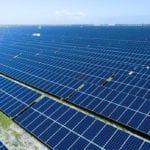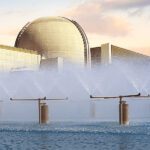COMMENTARY
This article is one of two posts in POWER’s Point-Counterpoint series. The views and opinions expressed within the content are those of the author(s) and do not necessarily reflect the views and opinions of POWER or any of its affiliates. To read the opposing viewpoint, please see: “New Nuclear Isn’t Worth Public Investment.”
Many people who believe we need a “Green New Deal” will say that Earth faces an existential catastrophe that could cut short the lives of young people who are living now. But if nuclear energy is mentioned as part of the solution, they’ll say ominously that nuclear waste remains radioactive for 10,000 years.
This is the kind of irrationality that besets too many climate activists when it comes to nuclear energy. In fact, the small amount of nuclear waste that will be buried deep underground will pose little or no danger to anyone 10,000 years in the future. But even if it did, and activists’ apocalyptic predictions were true, human life would already have been extinguished long before due to our failure to transition to zero-carbon-emission energy.

More rational nuclear energy opponents point to its high cost compared to the cost of wind and solar. Perhaps they forget that nuclear energy was the lower-cost option until only a few years ago, when wind and solar’s costs finally descended after at least 40 years of concerted efforts to reduce them.
No comparable efforts were made to reduce nuclear energy’s costs. The efforts were made to increase its safety, which increased its cost, even after it became clear that it posed very little danger to human lives and health.
But is nuclear energy’s cost really too high now? This impression has in part been created by faulty comparisons of the cost of nuclear with the cost of wind and solar energy.
Nuclear and renewables cannot be compared on a stand-alone, levelized-cost-of-energy basis, as if the alternatives were only one or the other. They produce a completely different pattern of energy over time. Those patterns can beneficially combine.
If renewables were the only energy source, then, of course, they would need some means to even out the intermittency of their energy production—unless we are willing to use electricity only when the wind is blowing or the sun is shining. The technologies postulated to even out renewables’ intermittency are currently very expensive. Renewable energy supplemented by long-term battery storage, for example, is more expensive than renewable energy backed up by nuclear. A November 2018 Massachusetts Institute of Technology study compared the costs of a range of combinations of energy technologies to meet a requirement of zero-carbon emissions. The lowest-cost combination, using conservative cost projections, was not renewables plus storage but renewables and nuclear, with about half the energy coming from nuclear.
The Vogtle two-reactor expansion project continues to spark conversation about the future of utility-scale nuclear projects in the U.S. Want to learn more? Go here to read the latest about Plant Vogtle.
Sometimes nuclear opponents refer to nuclear as “prohibitively expensive.” And yet, its cost did not prohibit it from a rapid build-up in the 1970s through the 1990s, resulting in France’s electricity being 75% nuclear, Europe’s on average 33%, and the U.S. 20%.
Advocates for the all-renewables scenario rely on speculative projections of vastly reduced storage cost. But nuclear advocates can also rely on projections of reduced nuclear cost, which are much less speculative because they were achieved in the past. Rejuvenation of the nuclear energy support industries, standardization, better safety regulation, and advanced designs will reduce them.
Sometimes, fossil fuel plants with carbon capture and storage (CCS) are proposed as an alternative to nuclear, but that is truly speculative. Capturing the carbon dioxide (CO2) from all fossil fuels would require compressing and injecting deep underground 32 billion tons of CO2 a year. The total amount that can be captured currently is much less than a tenth of a percent of that, at very high cost. And CCS poses real dangers from the escape of CO2, a risk that has caused communities in Germany to reject the construction of CCS plants near them. To imagine that CCS will be a viable alternative to nuclear soon is a pipe dream.
An abundance of evidence has shown that, contrary to what was previously believed, the low levels of radiation released in serious nuclear mishaps, even at the level of Fukushima, are not dangerous to humans. Together with the record of no human deaths attributable to nuclear energy—except from the absurdly poorly planned and constructed power plant at Chernobyl—this evidence tends to strongly confirm nuclear energy’s basic safety. And furthermore, nuclear energy has the lowest ecological footprint of any energy source, with the possible exception of geothermal.
There’s such a thing as an obsession with safety to the detriment of safety itself. This is the obsession that has hampered nuclear energy—and still does. If regulation and popular perceptions of commercial air transport were as fearful and overcautious as regulation and perceptions of nuclear energy, air travel would be too costly for most travelers.
Like every other contributor to the energy transition, nuclear needs government as well as industry and popular support for it to develop and assume its rightful role. The immediate need is to eliminate the misconceptions about nuclear, so that it will be correctly perceived, like wind and solar, as fully “green.”
—Michael Edesess, PhD is an accomplished mathematician and economist with expertise in the finance, energy, and sustainable development fields. He is an adjunct associate professor in the Division of Environment and Sustainability at The Hong Kong University of Science and Technology, managing partner/special advisor at M1K LLC, and a research associate of the EDHEC-Risk Institute.











